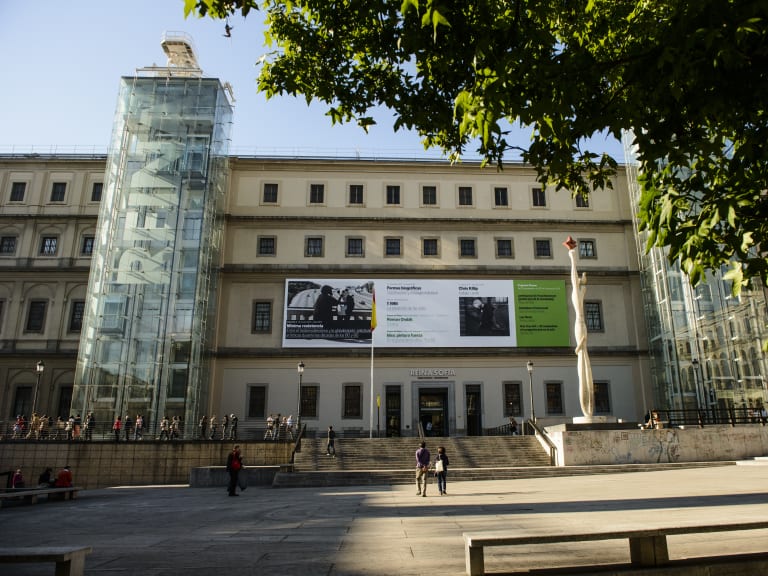More about: Reina Sofia Museum in Madrid: Tickets and Tours
In 1990 was born what is now one of the most important museums in Spain. Picasso, Miró, Dalí, Juan Gris, Delaunay, Yves Klein, or Francis Bacon are some of the artists of the Reina Sofía.
Buying tickets in advance and online is the most advisable option. It is not uncommon to find a queue of visitors several meters long in front of the stairs of the museum. Here are the best ways to visit the museum:

Madrid Reina Sofia Museum Tickets
The Reina Sofia, at your own pace and skipping the queues
Perfect if you want to visit the Reina Sofia museum at your own pace, without having to join a guided tour but want to skip the ticket office lines.
It is not uncommon to find a long line at the doors of the museum formed by those who have not yet taken their tickets to see the permanent collection or temporary exhibitions and are waiting to access the box office.
You can save yourself the wait by booking your tickets online for the Reina Sofia: you only have to choose the day you want to visit the museum. Once you make the online reservation of tickets for the Reina Sofia you will receive a receipt to your email to exchange for your ticket at the museum on the day chosen for your visit.
Why I like this option: this is the most economical option to visit the museum at your own pace.
Recommended if... you want to visit the museum with the minimum budget.

Madrid Reina Sofia Museum Guided Tour
Tour the interior of the Reina Sofia Museum with an expert guide
If you want to discover the most interesting works of the Reina Sofia by the hand of a specialized guide, join this guided tour.
If you want to see the museum in an hour and a half and without missing the main landmarks of its collection, I recommend this guided tour that includes a skip-the-line ticket. The experience of visiting the museum with a guide will make you discover the works in a much more intimate and personal way and, of course, learning important lessons about contemporary art.
A guided visit to the Reina Sofia is worthwhile in any museum and certainly in this one even more so since contemporary art has behind it a cultural context rich in nuances that are not perceived at first glance.
Why I like this option: visiting a museum with a specialized guide to help you contextualize everything you see seems essential, and the Reina Sofia Museum, with the amount of art it houses, could not be less.
Recommended if... you want to know what is behind the essential works of the Reina Sofia with a specialized guide.

Madrid Prado Museum and Reina Sofia Museum Guided Tour
Visit the Prado and Reina Sofía museums with an expert guide
The Prado Museum and the Reina Sofia are two must-see museums in Madrid and getting to know them with an expert guide will help you get the most out of your visit.
The Reina Sofia and the Prado Museum are essential for all art lovers visiting Madrid. The Spanish art tour is not complete without one of these two museums as they both cover different periods.
On a joint guided tour of the Prado and Reina Sofia you can have access to both with an expert guide who will explain their main works.
If you have little time to visit these museums, this is a highly recommended option: the price is about $97 and tickets are included for both museums without queues.
Why I like this option: with this very affordable pack you can visit the two most important museums with an expert guide.
Recommended if... you want to enjoy the art of these two museums in Madrid accompanied by a guide and save time and money, as it is cheaper than if you booked both visits separately.

The Reina Sofia, at your own pace and skipping the queues
Perfect if you want to visit the Reina Sofia museum at your own pace, without having to join a guided tour but want to skip the ticket office lines.

Tour the interior of the Reina Sofia Museum with an expert guide
If you want to discover the most interesting works of the Reina Sofia by the hand of a specialized guide, join this guided tour.

Visit the Prado and Reina Sofía museums with an expert guide
The Prado Museum and the Reina Sofia are two must-see museums in Madrid, and getting to know them with an expert guide will help you get the most out of them.
How to buy tickets for the Reina Sofia at the box office

If you have not reserved your ticket you can go to the ticket office and buy it there for direct access, but you will probably have to wait in line in high season or in the middle of the day. You will not save much by buying your ticket at the box office, but if you are going to do it, it is better to go early in the morning to visit the museum with more tranquility and fewer tourists.
What works to see at the Reina Sofia

The differences between contemporary art and classical art are remarkable: classical art tells a story or a point of view framed within a historical and cultural context. The case of contemporary art is different: it seeks experimentation, rupture and emotion. This does not mean that 20th century works do not have a context behind them; they do, and they also have a series of influences. Therefore, I recommend you to go to the Reina Sofia knowing the following:
Picasso's Guernica
It is the most famous work of the museum and one of the most famous of the twentieth century. This huge canvas occupies a room of the museum and with its dimensions you can appreciate in detail the historical episode it represents. It is interesting to note how the cubist technique and black and white manage to convey a high emotional charge. If you use the audio guide, you can reserve about twenty minutes for the commentary of this painting as it presents many of the characters and elements of the canvas.
The Open Window by Juan Gris
The author of this work is considered one of the great masters of Cubism. He coincided with Pablo Picasso in Paris and it was there where he developed this technique with the variant of combining different elements on the canvas to give the final sensation of collage. This work is a good example of it.
The house of the palm tree by Joan Miró
We usually associate Miró with surrealism, but this work is a sample that this is not the only artistic period the artist went through. La casa de la palmera belongs to one of his first stages, when he decided to become a painter while recovering from a serious illness. Although it is an ordinary landscape, one can perceive in it a certain dreamlike air that later would lead to surrealism.
Girl at the Window by Salvador Dalí
Dalí also had other more conceptual stages before plunging fully into surrealism and this supposed portrait of his sister is an example of this. He made the painting during his formative years when he was still outlining his technique and to this day it remains one of the most admired of his oeuvre.
Francis Picabia's Totalizer
In the 20th century, machines and technology had an important presence in art. Picabia, after having experimented with Dadaism, applies in this work the idea of mechanization to the sexual act using circular forms.
A world of Holy Angels
Avant-garde art was also dominated by men, which is why this artist was until recently an unknown. This canvas, three meters high and three meters wide, is the result of the intuition of its author, since she did not know the new artistic trends as well as her male colleagues, who were perfectly integrated in the artistic circuit. To paint this picture the author said she was inspired by some verses of Juan Ramón Jiménez.
The Great Masturbator by Salvador Dalí
This is one of Dalí's best known paintings, who was fiercely criticized by his contemporaries for refusing to fight in the Spanish Civil War and for staying in the country afterwards during Franco's dictatorship. However, Dalí's genius was recognized by all. This work aims to reflect the transformation that the appearance of his lover Gala meant for a painter always obsessed with sexuality or sanity.
Painting (snail, woman, flower, star) by Joan Miró
In this painting we can recognize more of the surrealist profile that we associate with Miró. The joy of his previous paintings gives way in this canvas to the drama and anguish experienced during a period when fascism was on the rise throughout Europe and Spain was preparing for a civil war.
Characters leaving a rock concert by Guillermo Pérez Villalta
Who has not heard of the movida madrileña? The painting by this artist from Cadiz is a tribute to this period. With a technique closer to narrative, he incorporates figurative strokes in this work in which he represents different stereotypes or characters of the Madrid nightlife.
Woman in Blue by Pablo Picasso
Picasso is best known for cubism, but we often forget that there were other stages in the artist's life. This painting, for example, belongs to his so-called blue period, marked by the pain in which the artist is plunged after the suicide of a friend and characterized by the use of this tone in his paintings.
How to get to the Reina Sofia

The museum is located in front of the Atocha station. The main entrance is in the square renamed "Juan Goytisolo", but few know it by that name. The easiest way to get there is by metro. If you get off at the Estación del Arte metro stop, you can get there by going straight on from the exit and turning right a few meters away.
The surroundings of the Reina Sofia
The museum is located in one of the most central areas of Madrid, so you will find the area very lively. I recommend that you look for Argumosa street where you can enjoy a few beers in any of its pleasant terraces belonging to the traditional neighborhood of Lavapiés.
Organize your visit to the Reina Sofia Museum

When to go
The Reina Sofia Museum is closed on Tuesdays. On Sundays it is open from 10 am to 2:30 pm and the rest of the days it opens at 10 am and closes at 9 pm. As in the afternoons from 19 pm begins the free hours, there are usually many more people, so it is ideal to go early in the morning any day during the week. You will need about two hours to see the museum so, if you are going to take advantage of the free hours, go around 6 or 6:30 pm to get in line.
Audioguide
The audio guide costs about 4.50 euros, reduced for students and groups. I recommend a first visit to the museum without it to enjoy the works in general and see what each one transmits to you without being conditioned by its context. On a second visit you can return to see the works that have most impacted you and put them in context with the information that the audio guide will give you. You will be in for more than one surprise.
Where to eat
There are several places to eat around the museum. One of the most legendary is El Brillante, a bar where you will be served the famous squid sandwich for which the city of Madrid is famous. However, the prices are quite high, so I recommend any other restaurant in the area; you have plenty to choose from. If you finish seeing the museum at brunch time, the museum restaurant, Nubel, is a very nice place where the brunch is very good.
Go to the Reina Sofia with children

The museum has different activities to bring children closer to both the permanent collection and temporary exhibitions. Before visiting, find out how you can make the visit more accessible to the little ones of the house because you also have guides in the museum store to help you in this task.
Other interesting museums
If you want more, be sure to visit the Prado Museum. Located a few meters from the Reina Sofia, the Prado is a cultural jewel that art lovers can not miss. I tell you how in my article on Prado Museum in Madrid: Tickets and Tours.
Other interesting activities in Madrid

Madrid is a big city, very prepared to walk around and tour the whole city. Therefore, I can not fail to recommend you to take a guided tour of the city. Well, for that and because as you have already seen, Madrid breathes history in every corner. In this article about 12 Best Tours in Madrid you have all the information you need to choose the best guided tour for your trip.
And if you prefer to rest a little between walks, you can continue enjoying Madrid aboard its famous tourist bus. Although a priori it may seem a little 'guiri' option, it is still comfortable and practical to move from end to end from the top of the bus. Here you have all the information you need to know: Madrid Hop-On Hop-Off Buses.






















